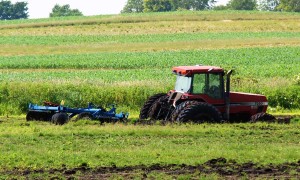
University of Wisconsin Extension News
Safety and caution need to be used in these types of situations.Here are some tips for safe towing practices.
After the fourth wettest summer on record, heavy rains are hampering the start of the harvest season. Getting equipment stuck in the mud is a frustrating situation. Safe towing practices are required to prevent damage to machinery or injury to operators.
Select a proper towing device. Don’t grab the first rope or chain that you find in the shop and use it as for a towing device. The towing device (rope, cable or chain) will be put under a significant pulling force or tension.Soil conditions and time or surface condition also need to be taken into consideration when choosing the proper towing device. If this device or a part of the device, such as a hook, breaks; the towing device suddenly becomes a dangerous projectile. While a one inch nylon rope has a stronger breaking strength than a cable or chain, when a nylon rope breaks it snaps back to its point of attachment. Steel cables upon reaching a breaking point will rebound in an unpredictable manner and wrap around any object in its path. A long towing chain designed to support the towed load is recommended over nylon ropes or cables. Chains will break at their weakest point so check welds and hooks prior to use. Serious, disabling injuries and deaths have occurred when a towing device failed. Tractor and truck cabs may not stop the force of the towing device and the recoiling device may strike the operator.
Attach the towing device to the pulling vehicle properly. If using a tractor it is important to attach the towing device to the drawbar. Improperly hitching to anything other than the drawbar significantly increases the chances for a rear overturn. Truck bumpers are not recommended attachment points as the pulling forces may take off the bumper and the bumper then becomes a flying object. Refer to the operator’s manual for additional safe towing information. More than one pulling vehicle may be required. In this situation, attach each vehicle with a separate towing device. Attaching vehicles in single file exerts too much power on the towing device between the second tractor and the stuck piece of machinery.
Clear the area of unnecessary by-standers. Before starting to pull out the stuck machinery, clear the area of unnecessary by-standers and helpers. Ask these individuals to leave the area.
Initiate the towing process with caution. Double-check all attachments to see that they are secure. If using more than one pulling vehicle, efforts will need to be coordinated carefully between all operators. Be sure that everyone is wearing their seatbelt and clearly communicate the plan with everyone involved in the process. Each operator should understand the situations that will stop the towing process. If using hand signals to communicate between operators, inform everyone of the hand signals to be used and what the motions will mean to them. When the towing process begins, apply power smoothly without jerking. At the slightest sign of danger, tractor front-end off the ground, slip in attachment of towing device, the towing process should be stopped and re-evaluated before continuing.
Remember, the safest way to pull a stuck machine is always to use proper pulling equipment in good condition, attach it properly, and apply power slowly.
Source:uwex.edu